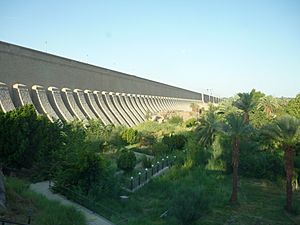Aswan Low Dam facts for kids
The Aswan Low Dam, also known as the Old Aswan Dam, is a very important dam built across the Nile River in Aswan, Egypt. It was the first dam ever built across the Nile. The British built it between 1899 and 1902. When it was finished, it was the largest dam made of stone (masonry) in the whole world. This kind of dam stays in place just by its own heavy weight.
The dam is located near what used to be the first big waterfall, or "cataract," of the Nile. It is about 1000 kilometers (620 miles) upstream from Cairo. Building something this big was a huge challenge at the time.
Why the Dam Was Built
The main reason for building the Aswan Low Dam was to store the Nile River's yearly floodwaters. This stored water was then used during the dry season. It helped farmers get enough water for their crops through irrigation. This meant more food could be grown for the people of Egypt.
When the dam was first planned, its height was kept lower than it could have been. This was done to protect the ancient Philae Temple, which was dedicated to the goddess Isis. Later, this temple was carefully moved to a new island called Agilkia Island in Lake Nasser to keep it safe from the rising water.
Raising the Dam
Over time, it became clear that the dam could not store enough water for all the new farming plans. So, the dam was made taller two times. The first time was between 1907 and 1912, and again from 1929 to 1933.
Even after being raised, the dam still couldn't meet all the needs for irrigation. In 1946, the water almost went over the top of the dam because people tried to store as much as possible. This led to the decision to build an even bigger dam. The Aswan High Dam was built about 6 kilometers (3.7 miles) upstream from the Old Aswan Dam.
Making Electricity
The Aswan Low Dam has another important job: it helps make electricity. The water held back by the dam flows through special machines called water turbines. These turbines spin powerful generators that create electricity. This way of making power from water is called hydroelectricity.
This technology was developed in the 1800s in countries like England and Germany. By 1900, it was being used in the United States and many European countries. Egypt was able to use this technology because it was under British control at that time. The ruler of Egypt, called the Khedive, was Abbas II. He usually had to agree with what the British wanted. The Aswan Low Dam still helps provide electricity today.
See also
 In Spanish: Presa baja de Asuán para niños
In Spanish: Presa baja de Asuán para niños


